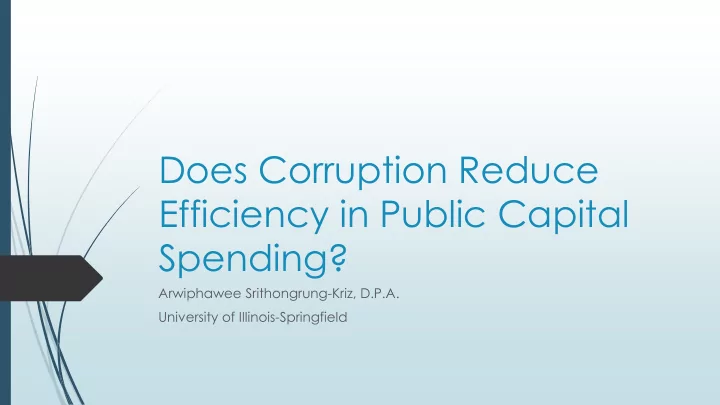

Does Corruption Reduce Efficiency in Public Capital Spending? Arwiphawee Srithongrung-Kriz, D.P.A. University of Illinois-Springfield
Study’s Motivation Liu & Mikesell (2014): corruption increased state capital spending Liu et al(2017): corruption increased state-local debt How does the corruption elevate capital spending level? Leviathan government Greedy bureaucrats Do we have more specific (economic) explanation; and if so, is it tested? Allocative Efficiency? Technical Efficiency?
Source: Kalahan, Rossolini & Shughart II (2006) Economics of Governance , 7, 211-227. Swaim, C. (2017) Wichita State Gave More Than $7.1 Million to Innovation Campus Nonprofit in Its First 3 Years. Sunflower Newspaper.
Corruption and Public Spending Grease in the wheels Versus Sands in the wheels hypotheses (Moen, 2010) Rents and rent seeking behaviors in public projects (Aidt, 2016) Free market prices interrupted by bidding collusion (Arozamena & Weinschelbaum, 2009) Allocative efficiency: lowest cost firms lose contract awards; higher prices for the similar qualities (Bose, 1995) “white elephant projects” (Lambsdorff, 2003) Project cost include bribes and kickbacks added by winning bidders (Dastidar & Mukherjee, 2014) Large projects saw more corruption; relatively low opportunity cost, if detected (Gautier & Goyette, 2016)
U.S. State Highway Production In 2014, 26,784 contracted projects; $42 billion in total (American Road and Transportation Builders Association, 2015) Scoring auctions: cost, time, road user price (Dastidar & Mukherjee, 2014) Corruption Procurement Coalition (CPC) (Hudon & Garzon, 2016) CPC was a set of informal networks Members form different organizations with discretion and authorization power Effects were to inflate contracting values, circumvent monitoring, and redistribute rents When the Canadian government dismantled the CPC infrastructure contract values were reduced by 20-30% Modus operandi in public construction projects Data availability (U.S. Federal Highway Administration, Highway Statistics, various years)
Model Cobb-Douglas Production Function* Q(L,K) = A L β K α Where: - Q is the quantity of products. - L is the quantity of labor. - K is the quantity of capital. - A is a positive constant. - β and α are constants between 0 and 1 K/L, Natural Resources, Human Capital O’Toole & Tarp’s (2014) Testing Model: Productivity growth = f (capital, labor, natural resources, human capital, corruption incidences, cross-state variation in production process) *Source: https://economicpoint.com/production-function/cobb-douglas
Highway Spending Efficiency Measurement North Dakota Texas Indiana Productivity Measurement South Dakota Vermont Florida Output/Input Rhode Island Nevada New Mexico Input: Pennsylvania Iowa Illinois Arizona Total state administered lane mile Delaware Georgia % mileage in good condition Ohio Montana Kentucky Total traffic flows Maine Oregon Minnesota Output Connecticut Louisiana Colorado Total outlays for new projects Wyoming California Idaho Maintenance spending Massachusetts New York New Jersey Annual Productivity Growth Rate Alabama Oklahoma (%) Tennessee New Hampshire Nebraska North Carolina Wisconsin Arkansas Observation Mean Standard Minimum Maximum South Carolina Missouri Deviation Washington Utah Mississippi 480 1.4 1.2 0.1 6.6 Kansas Michigan West Virginia Maryland Virginia -30.0% -20.0% -10.0% 0.0% 10.0% 20.0% 30.0% 40.0% 50.0% 60.0%
Variables Coefficients Standard Errors t-values Results Dependent Variable: Productivity Growth (∆ TFP) ∆ Federal grant (% to total capital outlay) -.324 .001 -243.19 ∆ Construction size (total construction/total state highway disbursement) .156 .000 356.59 ∆ Administrative size (total state highway administrative spending/total -.888 .006 -144.31 state highway disbursement) ∆ Labor (total number of state government employment/total 1.226 .071 17.8 employment) ∆ Human capital 1 (% civil engineers/total employment) -.76 .02 -48.7 ∆ Human capital 2 (% civil engineering technician/total employment) .85 .009 87.43 ∆ Natural resource (precipitation, inch of rain & snow) .005 .000 141.01 ∆ Corruption incidences (corrupt employees / 10,000 population) -.133 .000 -197.58 ∆ Corruption controlling effort (# caseloads per judge) -.000 .000 -116.96 State fixed effects INCLUDED INCLUDED Time fixed effects State production processes INCLUDED Adjusted R-square 0.68
Summary Statistics (back-up) Variable Obs. Mean Std. Dev. Min Max ---------------------------------------------------------------------------------------- tfp 480 1.36 1.149 .09 6.62 fed 480 30.08 10.89 8.25 66.22 perconstruct 480 .66 .69 .16 8.40 peradmin 432 .12 .09 00.00 .50 L 480 .14 .02 .09 .21 -------------+-------------------------------------------------------------------- pcivileng 476 .12 .04 .05 .36 pciviltech 471 .05 .03 .00 .42 precip 480 36.69 15.34 5.37 72.67 corruptemp 478 .50 .39 00.00 2.73 per_caseload 480 448.17 160.97 138.00 2,452.00
Recommend
More recommend